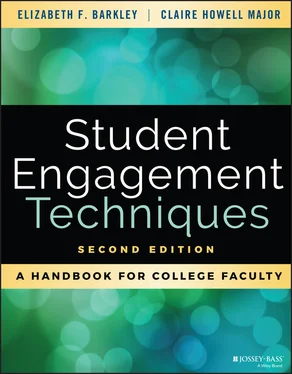Elizabeth F. Barkley - Student Engagement Techniques
Здесь есть возможность читать онлайн «Elizabeth F. Barkley - Student Engagement Techniques» — ознакомительный отрывок электронной книги совершенно бесплатно, а после прочтения отрывка купить полную версию. В некоторых случаях можно слушать аудио, скачать через торрент в формате fb2 и присутствует краткое содержание. Жанр: unrecognised, на английском языке. Описание произведения, (предисловие) а так же отзывы посетителей доступны на портале библиотеки ЛибКат.
- Название:Student Engagement Techniques
- Автор:
- Жанр:
- Год:неизвестен
- ISBN:нет данных
- Рейтинг книги:3 / 5. Голосов: 1
-
Избранное:Добавить в избранное
- Отзывы:
-
Ваша оценка:
- 60
- 1
- 2
- 3
- 4
- 5
Student Engagement Techniques: краткое содержание, описание и аннотация
Предлагаем к чтению аннотацию, описание, краткое содержание или предисловие (зависит от того, что написал сам автор книги «Student Engagement Techniques»). Если вы не нашли необходимую информацию о книге — напишите в комментариях, мы постараемся отыскать её.
— — — —
Student Engagement Techniques
"Student Engagement Techniques
"Student Engagement Techniques
"This book is an essential resource for faculty seeking to better engage with their students. Anyone seeking a clear, research-based, and actionable guide needs a copy of Student Engagement Techniques on their shelf!"
Student Engagement Techniques — читать онлайн ознакомительный отрывок
Ниже представлен текст книги, разбитый по страницам. Система сохранения места последней прочитанной страницы, позволяет с удобством читать онлайн бесплатно книгу «Student Engagement Techniques», без необходимости каждый раз заново искать на чём Вы остановились. Поставьте закладку, и сможете в любой момент перейти на страницу, на которой закончили чтение.
Интервал:
Закладка:
Expectancy-Value Theory
Brophy (2004) and Cross (2001) observe that much of what researchers have found can be organized within an expectancy × value model, which has much to offer our understanding of student motivation. This model holds that the effort that people are willing to expend on a task is the product of the degree to which they expect to be able to perform the task successfully (expectancy) and the degree to which they value the rewards as well as the opportunity to engage in the processes involved in performing the task itself (value). Effort is viewed as the product rather than the sum: it is assumed that people will expend no effort if either element (expectancy or value) is missing entirely. People will not willingly invest effort in tasks that they do not enjoy and that do not lead to something they value even if they know that they can perform the tasks successfully, nor do they willingly invest effort in even highly valued tasks if they believe that they cannot succeed no matter how hard they try.
Expectancy
Students' expectations are inextricably linked with their self-perceptions. Students must have confidence that, with appropriate effort, they can succeed. If there is no hope, there is no motivation. Cross and Steadman (1996) discuss three motivational theories that address student expectations: self-efficacy theories, attribution theory, and self-worth models. Self-efficacy theories (Bandura, 1977, 1982; Corno & Mandinach, 1983) suggest that students' beliefs about their ability to succeed at a learning task are more important than their actual skill levels or the difficulty of the task. If a student is confident in her ability to perform a task successfully, she will be motivated to engage in it.
Attribution theory (Weiner, 1974, 1985, 1986) suggests that students attribute success or failure to a variety of factors such as ability, effort, luck, fatigue, the ease or difficulty of the exam, and so forth, and that their belief is shaped by their perceptions of why they have succeeded or failed in the past. For example, if success is dependent on attributes over which they have control (effort), students are more likely to have confidence than when success is dependent on external conditions over which they have no control (difficulty of the exam). Three important dimensions of attributions include locus (whether failure or success is attributed to causes internal or external to the learner); stability (whether the attributed cause is permanent or temporary); and controllability (whether the learner has the power to influence success or failure).
Finally, self-worth models propose that people are strongly motivated to preserve their sense of self-worth. When students don't succeed, they would prefer to question—and have others question—their effort (they're “lazy”) rather than their ability (they're “dumb”) (Brown & Weiner, 1984; Cross, 2001). Based on this model, it is easier to understand why some students don't even try to accomplish a task if they believe there is low probability that they will be successful.
Covington (1993) found four typical student patterns that resonate with the experience many college teachers have interacting with students in the classroom. Success-oriented students are serious learners who want to perform well, and they usually do. They are predisposed toward engagement, as they enjoy learning for learning's sake. They find personal satisfaction in challenging assignments because they are accustomed to success and are able to preserve their perceptions of self-worth even in the event of an occasional failure. Overstrivers are also successful students and will take on challenging tasks, but they are not entirely confident in their ability, and consequently worry constantly about their grades and performance. Anxious that each new learning task will be the one that exposes the lower levels of ability that they have so far been able to conceal, they compensate by expending a great deal of effort to ensure that they do succeed. Failure-avoiders also suffer anxiety, but because they have not always been successful in school, they are afraid that if they fail at a specific learning activity, they will prove to themselves and others that they lack the ability to succeed. In order to preserve their sense of self-worth, they avoid tasks that are too challenging. Finally, failure-accepting students have become so accustomed and resigned to academic failure that they feel hopeless. They respond to learning tasks with indifference (school is irrelevant and unworthy of their efforts) or even antagonism, and they are neither satisfied with success nor dissatisfied with failure (Cross & Steadman, 1996, pp. 79–84). In short, they have disengaged from the learning process.
Although the role of expectancy has received considerable attention in the study of student motivation, “value” is still a critical variable. Students are making the sacrifices necessary to get a college education because they believe in the value of the learning, the value of the degree, or both. Therefore, in our efforts to promote student engagement, it is useful to look at what the research says about how the concept of value influences student motivation.
Value
Clearly, students are more likely to complete a task if they value the activity. The expectancy-value model differentiates task value into four components: attainment value (i.e., importance of doing well), intrinsic value (i.e., personal enjoyment), utility value (i.e., perceived usefulness for future goals), and cost (i.e., competition with other goals) (Eccles et al., 1983). For college teachers, these different components of value likely ring true. Some students will value a task because they want to achieve, while others will simply enjoy it. Some will value a task because they believe it will help them in their future careers. Others will simply value it because they value other tasks less. These value constructs also are related to other theories of motivation. Self-determination theory, for example, suggests that at times we engage in behavior simply because we want to (Deci & Ryan, 1985, 2002). Settings that promote intrinsic motivation satisfy three innate needs: autonomy (self-determination in deciding what to do and how to do it), competence (developing and exercising skills for manipulating and controlling the environment), and relatedness (affiliation with others through social relationships). Students are likely to be motivated in courses that promote these three characteristics.
Csikszentmihalyi's (1993, 1997) concept of “flow” describes states of deep intrinsic motivation that sound a lot like deep engagement. He proposes that when we experience flow, action and awareness merge. We are so absorbed in the task at hand that irrelevant stimuli disappear from consciousness and worries and concerns are temporarily suspended. We lose track of time; in fact, it seems to pass faster. The activity becomes autotelic—worth doing for its own sake. Wlodkowski (2008) notes that helping students achieve a sense of flow is more possible than many instructors realize, and he identifies the following characteristics as contributors: (a) goals are clear and compatible, allowing learners to concentrate even when the task is difficult; (b) feedback is immediate, continuous, and relevant as the activity unfolds so that students are clear about how well they are doing; and (c) the challenge balances skills or knowledge with stretching existing capacities (Nakamura & Csikszentmihalyi, 2003, in Wlodkowski, 2008, pp. 267–268). Brophy (2004) observes that while some people seem to possess a flow personality, seeking out challenges and taking great pleasure in stretching their limits, others rarely experience flow because they fear failure and avoid challenging situations (p. 11).
Читать дальшеИнтервал:
Закладка:
Похожие книги на «Student Engagement Techniques»
Представляем Вашему вниманию похожие книги на «Student Engagement Techniques» списком для выбора. Мы отобрали схожую по названию и смыслу литературу в надежде предоставить читателям больше вариантов отыскать новые, интересные, ещё непрочитанные произведения.
Обсуждение, отзывы о книге «Student Engagement Techniques» и просто собственные мнения читателей. Оставьте ваши комментарии, напишите, что Вы думаете о произведении, его смысле или главных героях. Укажите что конкретно понравилось, а что нет, и почему Вы так считаете.












